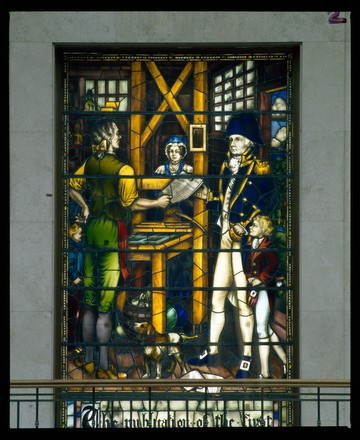The Sydney Gazette window
1940
Made by Frank G. O'Brien Pty. Ltd.
Presented by the proprietors of the Sun newspaper
The Sydney Gazette window on the western side of the room commemorates the printing of Australia’s first newspaper, the Sydney Gazette in March 1803. On the left side of the window, George Howe the paper’s printer, publisher, typesetter and proprietor presents a copy of the first issue to Governor Philip Gidley King. Next to Governor King is his son Phillip Parker King, and standing behind the printing press is his wife, Mrs King. The small boy partially obscured on the left of the scene is George Howe’s son Robert. Then serving as a printer’s devil (the nickname given to a printer’s apprentice), Robert later took over from his father as owner of the Sydney Gazette.
The window was presented to the Library by the Sun newspaper to commemorate the 500th anniversary of the invention of the printing press in 1440.
The Sydney Gazette
The Sydney Gazette was initially issued as a weekly publication. Fuelled by the colonists’ hunger for news and an easing of government regulations and censorship laws in 1824, it was being published twice weekly by 1825 and three times a week by 1831. The format was a single sheet folded into four pages, each typeset with three columns. Along with government-issued official notices dealing with shipping, the import of spirits, tickets of leave, and general orders regulating cargo boats and rules set by the governor, the paper published excerpts from English literature, educational items and poems, many of which Howe himself wrote.
The tone of the early issues of the Sydney Gazette has been described as 'moral to the point of priggishness, patriotic to the point of servility, pompous in a stiff, eighteenth century fashion'.* But it was also a vital part of Sydney life, keeping colonists abreast of local and selected international news, and facilitating business with its advertisements and commercial notices.
Light-fingered printer
Like many settlers, George Howe arrived in Australia as a convict, transported for shoplifting in 1800. A printer by trade with experience working at the London Times, he was quickly assigned the job of government printer. In 1802 he issued the first book printed in Australia, and in March 1803 began publication of the colony’s first newspaper, the Sydney Gazette. That same year he was pardoned and was fully emancipated in 1806. In 1813 he published the first illustrated book printed in Australia – a collection of 18 coloured plates of the birds of NSW by artist John Lewin.
Despite innumerable obstacles
Innumerable as the Obstacles were which threatened to oppose our Undertaking, yet we are happy to affirm that they were not insurmountable, however difficult the task before us. The utility of a PAPER in the COLONY, as it must open a source of solid information, will we hope, be universally felt and acknowledged, We have courted the assistance of the INGENIOUS and INTELLIGENT :--- We open no channel to Political Discussion, or Personal Animadversion :--- Information is our only purpose; that accomplished, we shall consider that we have done our duty, in an exertion to merit the Approbation of the PUBLIC, and to secure a liberal Patronage to the Sydney Gazette.
Sydney Gazette publisher George Howe, 1803
Chronically short
In its early years, the Gazette survived despite a chronic shortage of paper and ink, a small, antiquated press which had been brought out by the First Fleet, and the refusal or inability of many subscribers to pay their debts. At one point Howe threatened to publish the names of his debtors unless they paid up within a fortnight.
George Howe’s wife died on the voyage to NSW but his son Robert survived and helped in the printing office, later taking over the newspaper.



 Back to list
Back to list